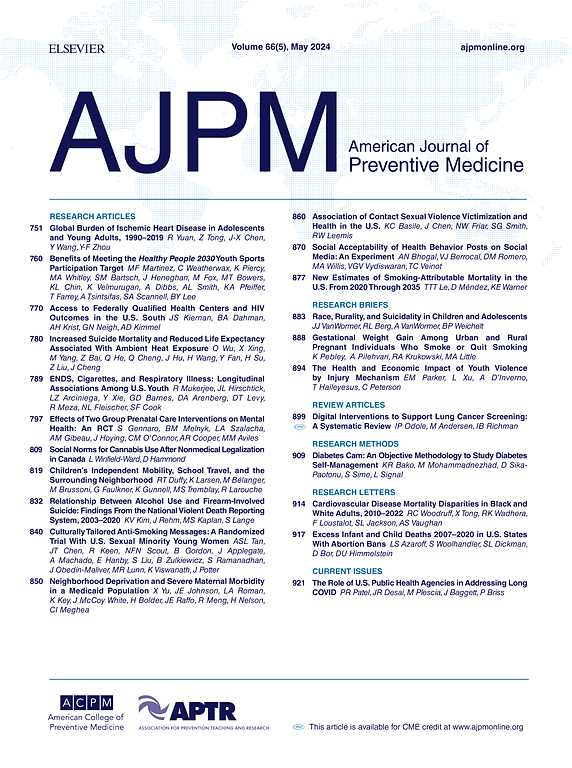农村公共卫生服务体系建设与传染病预防效果评价
IF 4.5
2区 医学
Q1 MEDICINE, GENERAL & INTERNAL
引用次数: 0
摘要
前言:结合区域发展与公共卫生需求的双重视角,探讨农村公共卫生服务体系发展路径,评估农村防疫效果。方法采用横断面数据和时空面板数据相结合的方法,构建覆盖24个农村示范点的多维评价框架。采用层次分析法(AHP)确定卫生资源配置优先级,采用空间Durbin模型阐明疾病传播的空间相关性特征。结果公共卫生系统完整性每提高10%,发病率降低6.8 ~ 9.2% (95% CI: 5.4 ~ 11.3)。关键驱动因素包括分级诊疗覆盖率(β=0.412)、数字监测响应及时性(β=0.357)和部门间协调效率(β=0.285)。空间计量分析显示,医疗可及性每增加一个标准差,社区发病率降低0.37个标准差(Moran’s I=0.216, p<0.05),旅游流量阈值(>38,000人/月)呈现负调节效应(γ=-0.154)。本研究建议建立早期预警机制和智能监测系统,结合动态卫生资源-区域需求匹配策略,有效增强农村公共卫生应变能力,开发可复制的预防模式。本文章由计算机程序翻译,如有差异,请以英文原文为准。
Construction of Rural Public Health Service Systems and Evaluation of Infectious Disease Prevention Effectiveness
Introduction
To investigate pathways for public health service system development and assess epidemic prevention efficacy in rural areas, integrating dual perspectives of regional development and public health demands.
Method
A multidimensional evaluation framework covering 24 rural demonstration sites was established through integration of cross-sectional data and spatiotemporal panel data. The Analytic Hierarchy Process (AHP) was employed to determine health resource allocation priorities, while the Spatial Durbin Model was utilized to elucidate spatial correlation characteristics of disease transmission.
Results
A 10% enhancement in public health system completeness reduced incidence rates by 6.8-9.2% (95% CI: 5.4-11.3). Key driving factors included graded diagnosis and treatment coverage (β=0.412), digital surveillance response timeliness (β=0.357), and interdepartmental coordination efficiency (β=0.285). Spatial econometric analysis revealed that one standard deviation increase in medical accessibility decreased neighborhood incidence by 0.37 standard deviations (Moran’s I=0.216, p<0.05), with tourist flow threshold (>38,000 persons/month) demonstrating negative regulatory effects (γ=-0.154).
Discussion
This study proposes establishing early warning mechanisms and intelligent surveillance systems, coupled with dynamic health resource-regional demand alignment strategies, to effectively enhance rural public health resilience and develop replicable prevention models.
求助全文
通过发布文献求助,成功后即可免费获取论文全文。
去求助
来源期刊

American Journal of Preventive Medicine
医学-公共卫生、环境卫生与职业卫生
CiteScore
8.60
自引率
1.80%
发文量
395
审稿时长
32 days
期刊介绍:
The American Journal of Preventive Medicine is the official journal of the American College of Preventive Medicine and the Association for Prevention Teaching and Research. It publishes articles in the areas of prevention research, teaching, practice and policy. Original research is published on interventions aimed at the prevention of chronic and acute disease and the promotion of individual and community health.
Of particular emphasis are papers that address the primary and secondary prevention of important clinical, behavioral and public health issues such as injury and violence, infectious disease, women''s health, smoking, sedentary behaviors and physical activity, nutrition, diabetes, obesity, and substance use disorders. Papers also address educational initiatives aimed at improving the ability of health professionals to provide effective clinical prevention and public health services. Papers on health services research pertinent to prevention and public health are also published. The journal also publishes official policy statements from the two co-sponsoring organizations, review articles, media reviews, and editorials. Finally, the journal periodically publishes supplements and special theme issues devoted to areas of current interest to the prevention community.
 求助内容:
求助内容: 应助结果提醒方式:
应助结果提醒方式:


